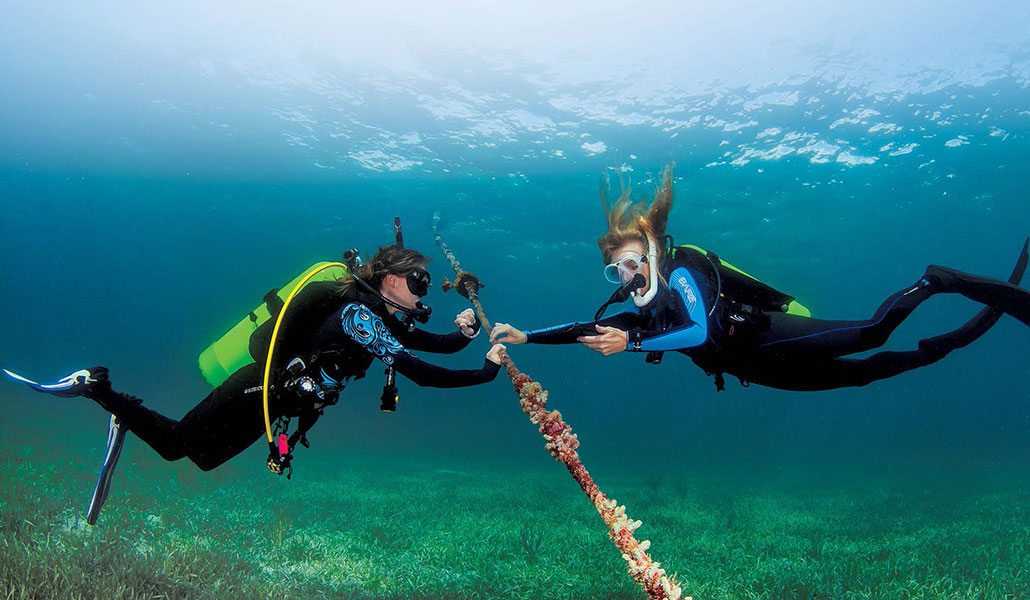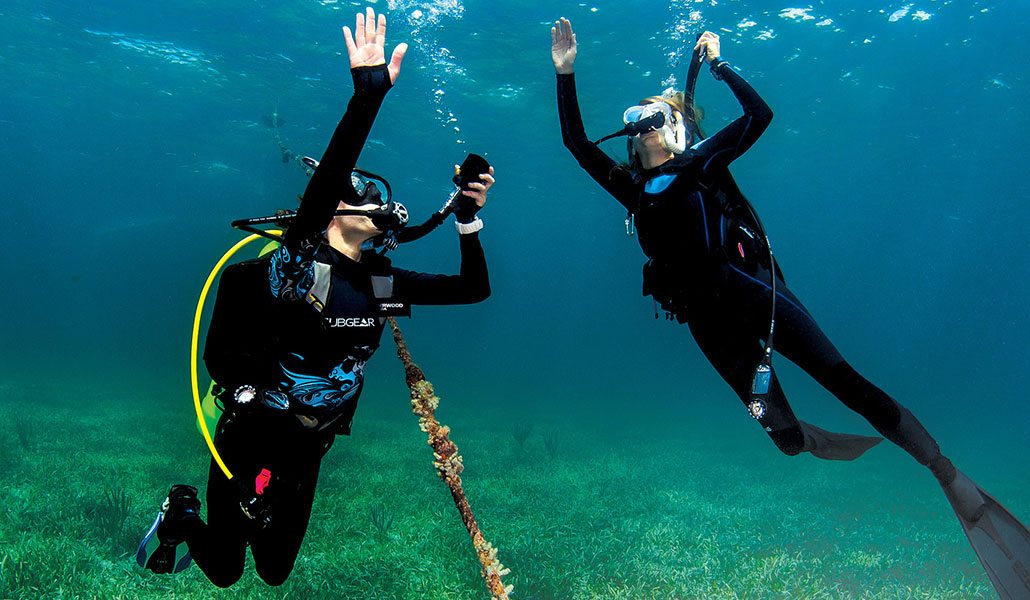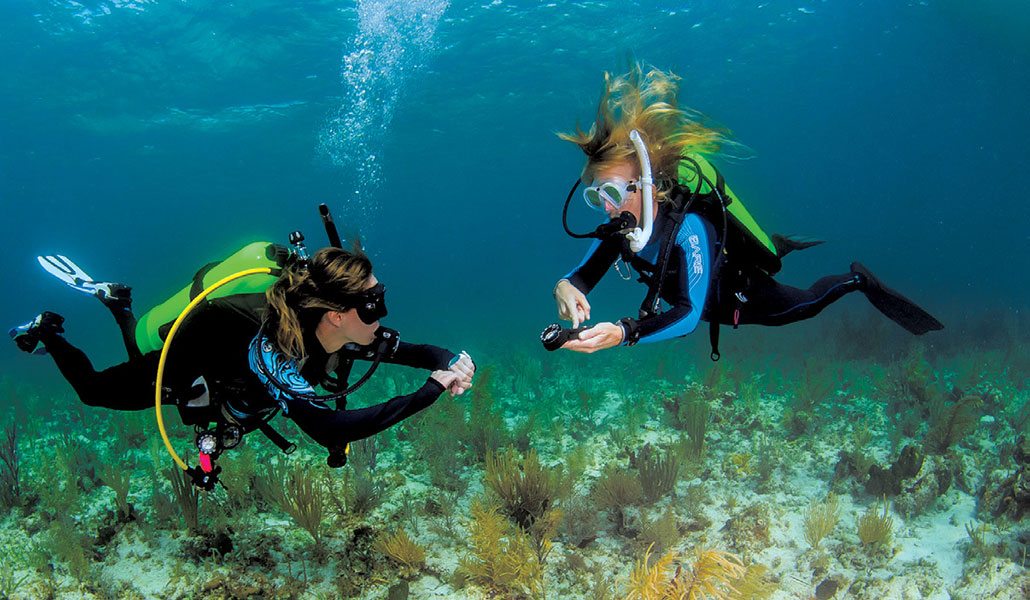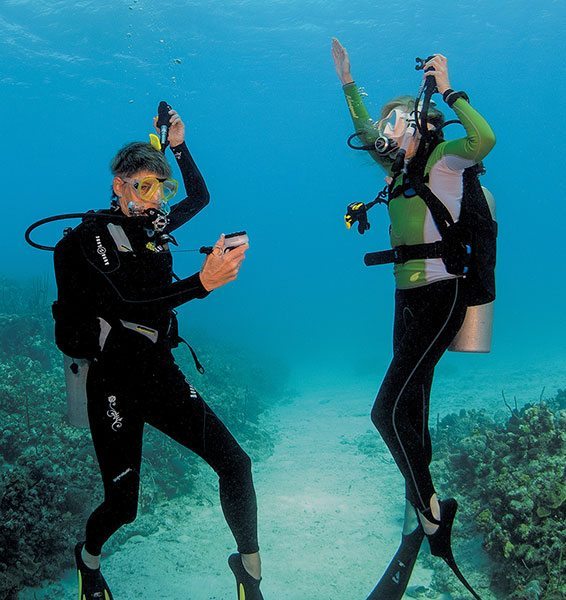SOME SAFETY SKILLS WE LEARN during Open Water scuba class are intended for use only in emergency situations. Because they are known to reduce the risk of decompression sickness (DCS), safety stops should be considered standard procedure for all dives below 33 feet (10 m); they should not be considered optional.
The depth most commonly associated with the term safety stop is 15-20 feet (5-6 m). Divers are taught to remain at this depth for at least three to five minutes, as it allows the body to offgas nitrogen accumulated in the tissues while at depth.
In recent years, new research into “two-phase” or bubble theories of decompression, including the Reduced Gradient Bubble Model (RGBM), has led divers, particularly those in the technical community, to incorporate an additional safety stop, known as a “deep stop,” into their dives. This means they routinely perform more than one safety stop before ascending to the surface, especially when diving at deeper depths and/or when doing repetitive, multiday dives.
At least one major scuba training agency (National Association of Underwater Instructors) has officially sanctioned this practice. Several leading dive computer manufacturers have incorporated deep stops into their algorithms.
According to a study done by researchers at the Divers Alert Network (DAN), a major finding when comparing various decompression models revealed that a deep safety stop, together with a shallow stop, yielded the lowest bubble grades (fewest silent bubbles). In fact, the optimal method for reducing post-dive bubble production (and therefore reducing the risk of DCS) was the combination of 1) an ascent rate of 30 feet [10 m] per minute with 2) a deep stop at about half the depth of the dive for 2.5 minutes and 3) a stop at 15 feet [5 m] for three to five minutes. The report concludes, “The introduction of a deep stop during decompression ascent appears to significantly decrease Doppler recorded bubbles and predicted gas tensions in the fast ‘tissues’ that may relate to actual gas exchange within the spinal cord. The authors conclude that such a deep stop may therefore significantly reduce the incidence of spinal cord-related decompression sickness.”
For example, if you and your dive buddy intend to dive to 100 feet (30 m), when concluding the dive, your dive plan would be to pause your ascent for a deep stop at 50 feet (15 m) for about 2.5 minutes, and then continue your ascent until you reach 15-20 feet (5-6 m), where you will perform your final safety stop for three to five minutes before making a slow ascent to the surface.
Although the primary reason for making that final safety stop is to allow your body to offgas, there are other advantages. First, the pause gives you the opportunity to look toward the surface for water conditions, hazards and approaching boat traffic. It is dangerous to make the stop or surface directly beneath the boat. As addressed in last month’s Scuba Skills column, it is safest to surface upcurrent and beside the boat.
The stop also allows you to check that your gear is secure for exiting and fine-tune your buoyancy for that final ascent to the surface. During the stop, have just enough air in the buoyancy compensator (BC) to keep yourself neutrally buoyant and able to maintain a constant depth by varying lung volume. As you begin the final ascent, any air in the BC will expand significantly; unless vented this may cause your buoyancy to become excessively positive. If this happens you’ll reach the surface faster than desired.
Safety-Stop Procedure
The following procedure applies to any safety stop, no matter the depth. Always make sure to monitor your air supply to ensure that you have plenty of air remaining to perform a safety stop or stops. Ascents should be made as a buddy team. At least one buddy should monitor ascent rate and depth and both need to keep an eye on their remaining air supply. Both also should be poised to vent expanding air from the BC.
As you near the desired stop depth, establish neutral buoyancy. In most cases this means venting air from the BC. However, be prepared to add a touch of air if you vent too much and begin to sink. The goal is to have the right amount of air in the BC to maintain neutral buoyancy and then make minor adjustment by varying lung volume.
Even though you are neutrally buoyant, still keep a close eye on your depth gauge. At the shallow depth of 15-20 feet, even the slightest increase in lung volume can cause you to begin floating toward the surface without even noticing. When this happens, whatever air remains in your BC will expand, intensifying the situation even more. So during the safety stop, always be prepared to control lung volume or/and cautiously vent or add air to the BC as necessary to remain at the desired depth.
A safety stop can be performed in either a vertical or horizontal position. If hovering in a prone position, your entire body is at the desired stop depth and is exposed to equal ambient pressure. When assuming a vertical orientation, position yourself so your chest is at the desired stop depth. In this position your lower torso and legs experience slightly increased ambient pressure, whereas the ambient pressure on your head and upper torso is less. This variation in pressure should not have a significant effect on achieving the desired off-gassing. The important thing is that you remain as near as possible to a constant depth during the stop.
Dive charter boats often hang a line or PVC bar over the side to safety-stop depth to help divers maintain a constant depth during the final stop. In calm water conditions you can use either as a reliable depth reference. Establish neutral buoyancy at the desired depth and hold onto the line or bar for the duration of the stop.
When surface conditions are choppy, the line/bar will move up and down. In this situation, establish your stop depth and proper buoyancy, then grasp the line/bar lightly. To keep from being jerked up and down by the line, let it slide through your hand as it moves. Likewise, hold the bar loosely and let your arm pivot from the shoulder. This allows you to remain at a constant depth and still have a reference.
Another thing to look out for when using a hang line or bar is current and/ or the boat swinging on the mooring. If you grasp the line at the proper safety-stop depth and there is significant current or the boat begins to swing, the line will cease to hang straight down and angle away from the direction of the water movement. If you’re holding onto the line you will drift shallower.
When diving from a moored (or anchored) boat, divers often end the dive at the bottom of the mooring and use the mooring line as a convenient reference during ascent. Upon reaching safety-stop depth, they pause for three to five minutes before continuing to the surface.
Common Pitfall
Many divers ascend slowly and perform a textbook-perfect safety stop at the end of every dive; then, when it is time to exit the water, they head for the surface without considering their ascent rate. Actually, these final few yards are the depth range in which they should be paying the most attention to how rapidly they ascend.
Before beginning the ascent from safety-stop depth, many experienced divers vent the remaining air from the BC and gently kick to the surface. Unless you are wearing a significant amount of weight, this technique is safe and eliminates the danger of an out-of-control ascent caused by expending air.
Once on the surface, inflate your BC and prepare to exit the water. And remember, “Safety stops are not optional.”
Story by Lynn Laymon | Photos by Barry and Ruth Guimbellot
See this skill in photos
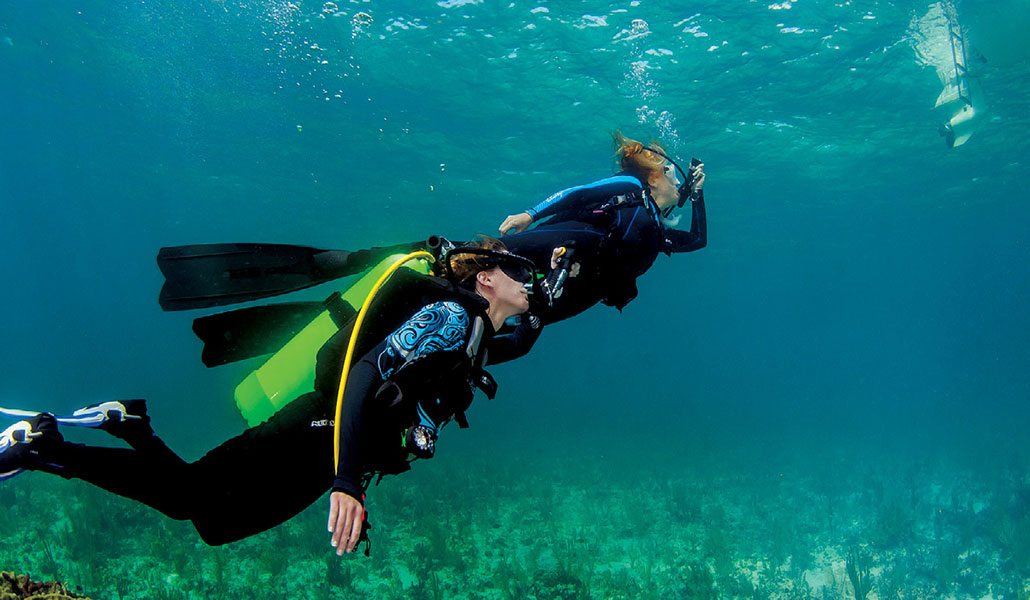
[TWO] Taking a diagonal route when surfacing from a safety stop slows your ascent and provides additional time to offgas.


